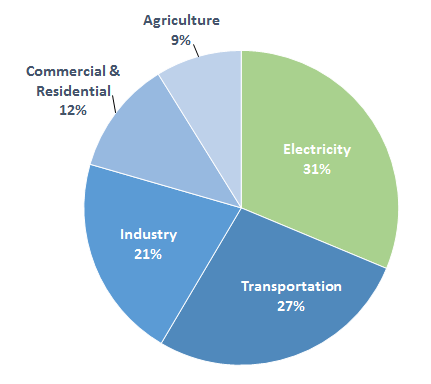Climate Change
Sources of Greenhouse Gas Emissions
- Overview
- Electricity
- Transportation
- Industry
-
Commercial
& Residential - Agriculture
-
Land Use
& Forestry
Commercial and Residential Sector Emissions

Total U.S. Greenhouse Gas Emissions by Economic Sector in 2013

Total Emissions in 2013 = 6,673 Million Metric Tons of CO2 equivalent
*Land Use, Land-Use Change, and Forestry in the United States is a net sink and offsets approximately 13% of these greenhouse gas emissions.
All emission estimates from the Inventory of U.S. Greenhouse Gas Emissions and Sinks: 1990-2013.
The residential and commercial sectors include all homes and commercial businesses (excluding agricultural and industrial activities). Greenhouse gas emissions from this sector come from fossil fuel combustion for heating and cooking needs, management of waste and wastewater, and leaks from refrigerants in homes and businesses. Indirect emissions, resulting from electricity consumed by homes and businesses, are discussed on the Electricity Sector page.
Residential and commercial activities contribute to emissions in a variety of ways:
- Combustion of natural gas and petroleum products for heating and cooking needs emits carbon dioxide (CO2), methane (CH4), and nitrous oxide (N2O). Emissions from natural gas consumption represent about 81% of the direct fossil fuel CO2 emissions from the residential and commercial sectors. Coal consumption is a minor component of energy use in both of these sectors.
- Organic waste sent to landfills emits CH4.
- Wastewater treatment plants emit CH4 and N2O.
- Fluorinated gases (mainly hydrofluorocarbons, or HFCs) used in air conditioning and refrigeration systems can be released during servicing or from leaking equipment.
More national-level information about emissions from the residential and commercial sectors can be found in the U.S. Inventory's Energy and Trends chapters.
Emissions and Trends
In 2013, direct GHG emissions from homes and businesses accounted for approximately 12% of total U.S. GHG emissions. Greenhouse gas emissions from homes and businesses have generally been increasing since 1990, but vary from year to year based on short-term fluctuations in energy consumption caused by weather conditions. Total residential and commercial GHG emissions in 2013 have increased by about 1% since 1990. Greenhouse gas emissions from on-site energy combustion in homes and businesses have decreased by about 1% since 1990 due to efficiency improvements in the residential and commercial sectors. However, indirect emissions from electricity use by homes and businesses have increased by 28% since 1990, due to increasing electricity consumption for lighting, heating, air conditioning, and appliances.
To learn about projected greenhouse gas emissions to 2020, visit the U.S. Climate Action Report 2014 (PDF) (310 pp., 23.1 MB).
Greenhouse Gas Emissions from Homes and Businesses

All emission estimates from the Inventory of U.S. Greenhouse Gas Emissions and Sinks: 1990-2013.
Reducing Emissions from Homes and Businesses
The table shown below provides some examples of opportunities to reduce emissions from homes and businesses. For a more comprehensive list of options and a detailed assessment of how each option affects different gases, see Chapter 8 of the Contribution of Working Group III to IPCC's Fourth Assessment Report.
![]()
| Type | How Emissions are Reduced | Examples |
|---|---|---|
| Homes and Commercial Buildings | Reducing energy use through energy efficiency. | Homes and commercial buildings use large amounts of energy for heating, cooling, lighting, and other functions. "Green building" techniques and retrofits can allow new and existing buildings to use less energy to accomplish the same functions, leading to fewer greenhouse gas emissions. Techniques to improve building energy efficiency include better insulation; more energy-efficient heating, cooling, ventilation, and refrigeration systems; efficient fluorescent lighting; passive heating and lighting to take advantage of sunlight; and the purchase of energy-efficient appliances and electronics. Learn more about ENERGY STAR. |
| Wastewater Treatment | Making water and wastewater systems more energy efficient. | Drinking water and wastewater systems account for approximately 3-4% of energy use in the United States. Studies estimate potential savings of 15-30% that are "readily achievable" in water and wastewater plants. [1] Learn more about Energy Efficiency for Water and Wastewater Utilities. |
| Waste Management | Reducing solid waste sent to landfills. Capturing and using methane produced in current landfills. |
Landfill gas is the natural by-product of the decomposition of solid waste in landfills. It primarily consists of CO2 and CH4. Well established, low-cost methods to reduce greenhouse gases from consumer waste exist, including recycling programs, waste reduction programs, and landfill methane capture programs.
|
| Refrigeration | Reducing leakage from refrigeration equipment. Using refrigerants with lower GWPs. |
Commonly used refrigerants include ozone-depleting hydrochlorofluorocarbon (HCFC) refrigerants, often HCFC-22, and blends consisting entirely or primarily of hydrofluorocarbons (HFCs), both of which are potent greenhouse gases. In recent years there have been several advancements in refrigeration technology that can help food retailers reduce both refrigerant charges and refrigerant emissions. Learn more about EPA's Greenchill Program to reduce greenhouse gas emissions from commercial refrigerators. |
References
- EPA (2012). Energy Efficiency for Water and Wastewater Utilities. Accessed 03/13/2012
